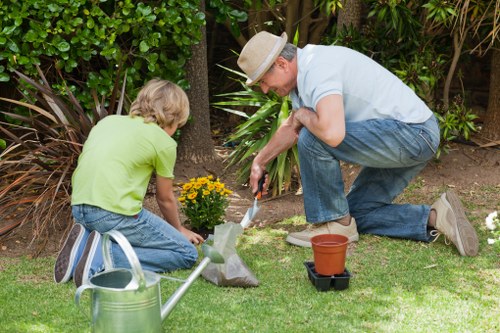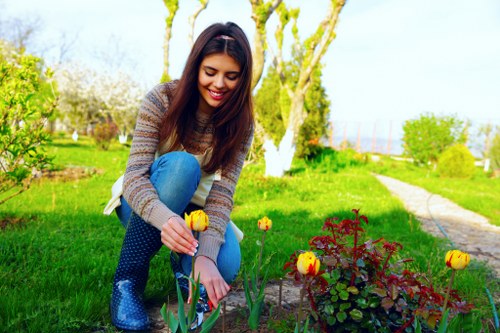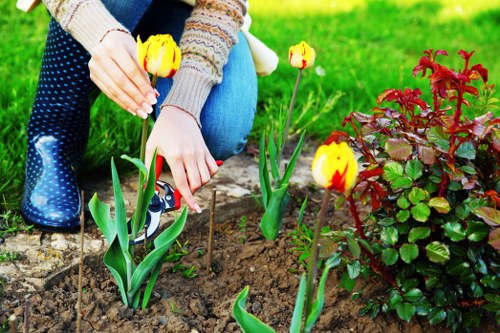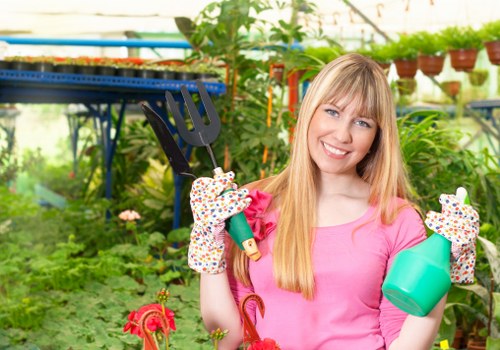Garden Fence Installation in Reading: A Comprehensive Guide

Installing a garden fence in Reading is a fantastic way to enhance the beauty, security, and privacy of your outdoor space. Whether you're looking to keep pets safe, define your garden boundaries, or add aesthetic appeal, a well-installed fence can make all the difference.
Before you begin your garden fence installation, it's crucial to plan carefully. Consider the purpose of the fence, the materials you'll use, and any local regulations or restrictions in Reading. Proper planning ensures that your fence not only looks great but also stands the test of time.
In this guide, we'll walk you through the essential steps for successful garden fence installation in Reading, covering everything from choosing the right materials to the actual installation process.
Choosing the Right Fence Material

The first step in garden fence installation is selecting the appropriate material. In Reading, where the climate can be quite variable, it's important to choose a material that is durable and suited to the local conditions.
Common fencing materials include:
- Wood: Offers a natural look and can be customized with paint or stain.
- Metal: Provides durability and security, with options like steel and aluminum.
- PVC: Low maintenance and resistant to weathering.
- Composite: Combines the look of wood with added durability.
Consider the maintenance requirements and lifespan of each material when making your decision. For example, wooden fences may require regular staining or painting to prevent rot, while metal fences typically require less upkeep.
Wooden Fences: Timeless and Versatile

Wooden fences are a popular choice for many Reading gardens due to their versatility and natural appearance. They can be tailored to various styles, from rustic to modern, and can be easily customized with different paints and stains.
However, wood requires more maintenance compared to other materials. Regular inspections for rot, pests, and weather damage are necessary to keep the fence in good condition.
If you choose wood, opt for rot-resistant species like cedar or treated pine to extend the lifespan of your fence.
Metal Fences: Strength and Security

Metal fences, such as those made from steel or aluminum, offer excellent strength and security. They are ideal for properties that require higher levels of protection or for those looking for a modern aesthetic.
Metal fences are generally low maintenance and can withstand harsh weather conditions better than wood. They are also resistant to pests and rot, making them a durable choice for Reading gardens.
Consider powder-coated finishes to enhance the appearance and longevity of your metal fence.
PVC and Composite Fences: Low Maintenance Options

PVC and composite fences are excellent options for those seeking low-maintenance solutions. PVC fences mimic the look of wood without the need for regular staining or painting, while composite fences combine wood fibers with plastic to create a durable and attractive material.
These materials are resistant to weathering, pests, and rot, ensuring your fence remains in good condition with minimal upkeep.
While they can be more expensive upfront, their longevity and low maintenance requirements often make them a cost-effective choice in the long run.
Planning Your Fence Layout

Once you've chosen your fencing material, the next step in garden fence installation in Reading is planning the layout. Proper planning ensures that your fence serves its intended purpose and complements your garden's design.
Start by measuring the area where the fence will be installed. Note any obstacles such as trees, shrubs, or existing structures that may affect the placement of your fence panels.
Consider the height and style of the fence in relation to your garden's overall aesthetic. For instance, a taller fence may provide more privacy, while a decorative picket fence can add charm without blocking views.
Determining Fence Height and Style

The height and style of your fence play a crucial role in both functionality and appearance. In Reading, local regulations may dictate maximum fence heights, so it's important to check with your local council before finalizing your plans.
Common fence heights range from 4 feet for decorative purposes to 6 feet for increased privacy and security. Choose a style that complements your home's architecture and enhances your garden's beauty.
Options include classic picket fences, solid panel fences, and ornamental metal designs. Each style offers different levels of privacy and aesthetic appeal.
Marking the Fence Line

Accurate marking of the fence line is essential for successful garden fence installation. Use stakes and string to outline the perimeter where the fence will be erected.
Double-check measurements to ensure that the fence aligns properly with property boundaries and any local regulations. This step helps prevent disputes with neighbors and ensures a professional-looking installation.
Consider consulting a property surveyor if there is any uncertainty about boundary lines in Reading.
Preparing for Installation

Preparation is key to a smooth fence installation process. Gather all necessary tools and materials before you begin, and ensure that the installation area is clear and accessible.
Common tools needed for fence installation include:
- Post hole digger or auger
- Level
- Measuring tape
- Concrete mix
- Hammer or nail gun
- Saw (if cutting is required)
Having the right tools on hand will make the installation process more efficient and reduce the risk of mistakes.
Setting Fence Posts

The foundation of any fence is its posts. Properly setting fence posts ensures the stability and longevity of your garden fence.
Begin by digging post holes to the appropriate depth, typically about one-third of the post's length. This depth helps anchor the posts firmly in the ground.
Place the posts in the holes, ensuring they are level and plumb. Fill the holes with concrete mix to secure the posts in place, and allow the concrete to cure according to the manufacturer's instructions.
Attaching Fence Panels

Once the posts are set, it's time to attach the fence panels. Start by aligning each panel with the posts, ensuring they are straight and evenly spaced.
Use appropriate fasteners, such as nails or screws, to secure the panels to the posts. For added stability, consider using brackets or reinforcing ties.
Ensure that each panel is level before moving on to the next one, maintaining a consistent appearance throughout your garden fence.
Finishing Touches

After the main structure of your garden fence is in place, add any finishing touches to enhance its appearance and functionality.
This may include:
- Painting or staining wooden fences to protect against the elements and match your garden's color scheme.
- Installing decorative elements, such as finials or lattice panels, for added visual interest.
- Adding gates for easy access to your garden areas.
Regular maintenance, such as cleaning and inspecting for damage, will help keep your fence looking great and functioning properly for years to come.
Maintaining Your Fence

Maintenance is essential to prolong the life of your garden fence. Depending on the material, maintenance tasks may include:
- Inspecting for and repairing any damage or wear.
- Cleaning the fence to remove dirt, algae, or mildew.
- Repainting or restaining wooden fences as needed.
- Lubricating hinges and latches on gates.
Regular maintenance not only keeps your fence looking its best but also prevents minor issues from becoming major problems.
Local Considerations for Reading

When installing a garden fence in Reading, it's important to take local factors into account. The area's climate, local building codes, and the specific characteristics of nearby areas can all influence your fence installation.
Reading experiences a temperate climate with moderate rainfall, so choosing weather-resistant materials like metal or PVC can be beneficial. Additionally, consulting local building regulations ensures your fence complies with height restrictions and other guidelines.
The unique features of nearby areas also offer inspiration and practical considerations for your fence design.
Nearby Areas to Reading for Garden Fence Installation

Here are some of the closest areas to Reading where you might consider garden fence installation:
- Tilehurst: Just west of Reading, Tilehurst offers a blend of residential and green spaces ideal for various fence styles.
- Whitley: Known for its suburban charm, Whitley is perfect for harmonious fence designs that complement traditional homes.
- Caversham: With its riverside locations, Caversham may benefit from fences that provide both security and aesthetic appeal.
- Emmerley: This area combines urban and natural elements, making versatile fencing options suitable.
- Earley: A bustling area with both residential and commercial properties, Earley requires durable and stylish fencing solutions.
- Finchampstead: Close to Reading, Finchampstead boasts beautiful gardens where elegant fences can enhance the landscape.
- Wokingham: South of Reading, Wokingham offers a mix of historic and modern homes, allowing for a variety of fence designs.
- Mortimer: A quiet suburb with ample green space, Mortimer is ideal for natural-looking wooden fences.
- Peppard: Known for its lovely parks, Peppard benefits from fences that blend seamlessly with the environment.
- Sonning: A picturesque area where decorative fencing can add to the scenic beauty.
- Shaw and Sonning: Offers both residential and rural settings, requiring fences that balance functionality and style.
- Tilehurst Meadows: Ideal for eco-friendly fencing options that complement the natural surroundings.
- Tile Aston: A serene area where fences can provide privacy without detracting from the tranquility.
- Redlands: Close to amenities, requiring durable fences that withstand frequent use.
- Incledon: A charming locality where classic fence designs enhance the overall appeal.
Cost Considerations

Understanding the costs involved in garden fence installation in Reading is important for budgeting purposes. The total cost can vary based on several factors:
- Material: Different materials come with varying price points. For example, wood may be less expensive upfront compared to metal or composite materials.
- Height and Length: Taller and longer fences require more materials, increasing the overall cost.
- Labor: If you're hiring professionals, labor costs will depend on the complexity of the installation and local rates in Reading.
- Permits: Some installations may require permits from the local council, which can add to the cost.
On average, garden fence installation in Reading can range from £500 to £3,000, depending on these factors. Obtaining multiple quotes from local contractors can help you find the best deal.
DIY vs. Professional Installation

Deciding between a DIY fence installation and hiring a professional is a key consideration. While DIY can save money, it requires time, effort, and some level of expertise.
Professional installers have the experience and tools to ensure the job is done correctly and efficiently. They can also provide advice on material selection and design that you might not have considered.
If you're comfortable with DIY projects and have the necessary skills, installing your own fence can be a rewarding experience. However, for larger projects or more complex installations, professional help is often worth the investment.
Permits and Regulations

Before starting your garden fence installation in Reading, it's essential to check local regulations and obtain any necessary permits. This ensures that your fence complies with building codes and avoids potential legal issues.
- Height Restrictions: Local councils may have limits on how tall your fence can be, especially if it's near property boundaries or public spaces.
- Material Restrictions: Certain materials or styles might be restricted in specific areas, particularly in conservation or historically significant zones.
- Boundary Permissions: If your fence is near a property line, you may need permission from your neighbors or local authorities.
Contact the Reading Borough Council or visit their website to find detailed information on fencing regulations in your area.
Environmental Considerations

Installing an eco-friendly fence is not only good for the environment but can also add a unique touch to your garden. Consider sustainable materials and practices to minimize your fence's environmental impact.
Sustainable fencing options include:
- Recycled Materials: Using recycled metal or composite materials reduces waste and conserves resources.
- Natural Wood: Sourced from responsibly managed forests, natural wood is biodegradable and renewable.
- Bamboo: A fast-growing, renewable resource that offers a unique aesthetic.
Additionally, proper installation and maintenance can extend the life of your fence, reducing the need for replacements and minimizing environmental impact.
Wildlife-Friendly Fences

If your garden in Reading is home to various wildlife, consider installing a fence that allows animals to move freely while still providing security. Wildlife-friendly fences can help protect local biodiversity and support a healthy ecosystem.
Options include:
- Gates: Allowing easy access for pets and wildlife.
- Open-Top Designs: Preventing birds and small animals from being trapped.
- Naturally-Created Barriers: Using hedges or stone walls to blend with the environment.
These designs help maintain the natural balance of your garden while providing the benefits of a fence.
Enhancing Garden Aesthetics

A well-installed garden fence can significantly enhance the aesthetic appeal of your Reading garden. Here are some tips to make your fence a beautiful addition to your outdoor space:
- Choose Complementary Colors: Match or complement your fence color with your house and garden features.
- Add Decorative Elements: Incorporate finials, lattice panels, or trellises for added visual interest.
- Incorporate Greenery: Climbing plants or hanging baskets can soften the fence's appearance and integrate it into the garden.
- Use Lighting: Adding lights to your fence can create a stunning nighttime display and improve security.
Thoughtful design choices can turn your fence from a functional structure into a standout feature of your garden.
Integrating Climbing Plants

Climbing plants can transform a plain fence into a vibrant, living structure. Vines like ivy, clematis, or climbing roses add color, texture, and fragrance to your garden.
When choosing plants, consider their growth patterns and maintenance requirements. Ensure that the plants you select are suitable for Reading's climate and your specific garden conditions.
Regular pruning and care will keep the plants healthy and prevent them from overwhelming the fence structure.
Incorporating Garden Lighting

Garden lighting can enhance the beauty and functionality of your fence after dark. Strategic placement of lights highlights architectural features and creates a welcoming ambiance.
Options include:
- String Lights: Add a festive touch and are easy to install.
- Spotlights: Highlight specific areas or decorative elements of the fence.
- Solar-Powered Lights: Energy-efficient and environmentally friendly.
Choose lighting that complements your fence style and meets your garden's needs.
Common Mistakes to Avoid

Even with careful planning, certain mistakes can occur during garden fence installation in Reading. Being aware of these common pitfalls can help you avoid them and ensure a successful project.
- Poor Planning: Failing to measure accurately or neglecting to check local regulations can lead to issues down the line.
- Choosing the Wrong Materials: Selecting materials that aren't suited to Reading's climate or your garden's needs can result in premature wear and tear.
- Improper Installation: Inadequate post setting or panel attachment can compromise the fence's stability and longevity.
- Ignoring Maintenance: Neglecting regular upkeep can cause minor problems to escalate, reducing the fence's lifespan.
By anticipating these challenges, you can take proactive steps to ensure your garden fence installation is smooth and successful.
Ensuring Proper Post Installation

The stability of your fence largely depends on the integrity of its posts. Improperly set posts can lead to wobbly or leaning fences, especially in adverse weather conditions common in Reading.
Make sure to:
- Set posts deep enough to withstand wind and soil conditions.
- Use concrete to secure posts firmly in place.
- Ensure posts are perfectly vertical using a level.
Taking the time to install posts correctly will prevent structural issues and ensure your fence remains upright and stable.
Overlooking Local Wildlife

Incorporating considerations for local wildlife is an important aspect of eco-friendly fencing. Overlooking this can disrupt the natural habitat and lead to unintended consequences.
To respect local wildlife:
- Choose fence materials that are safe for animals.
- Avoid using sharp or harmful fasteners that could injure pets or wildlife.
- Design fences that allow animals to pass through or around, promoting a balanced ecosystem.
Thoughtful design and material choices can help create a fence that is both functional and wildlife-friendly.
Final Thoughts on Garden Fence Installation in Reading

Installing a garden fence in Reading is a significant investment that can greatly enhance your property's value, security, and aesthetic appeal. By carefully selecting materials, planning your layout, and adhering to local regulations, you can achieve a successful and long-lasting fence installation.
Remember to consider both practical and environmental factors, and don't hesitate to seek professional assistance if needed. With the right approach, your garden fence will be a beautiful and functional addition to your Reading home for years to come.
Happy fencing!
Frequently Asked Questions

1. Do I need a permit for garden fence installation in Reading?
Yes, depending on the height and location of your fence, you may require a permit from the Reading Borough Council. It's important to check local regulations before starting your project.
2. What is the average cost of installing a garden fence in Reading?
The cost can range from £500 to £3,000, depending on factors like material choice, fence height, length, and whether you hire professionals or do it yourself.
3. How long does it take to install a garden fence?
The installation time varies based on the size and complexity of the project. On average, a standard garden fence can be installed within a few days to a week.
4. What is the best material for a low-maintenance garden fence?
PVC and composite materials are excellent for low-maintenance fences. They are resistant to weathering, pests, and rot, requiring minimal upkeep compared to wood or metal.
5. Can I install a garden fence myself, or should I hire a professional?
If you have the necessary skills and tools, a DIY installation can save money. However, for larger or more complex projects, hiring a professional ensures the fence is installed correctly and efficiently.